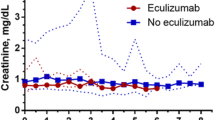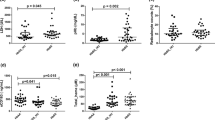Abstract
Thrombosis is a leading cause of morbidity and mortality in paroxysmal nocturnal hemoglobinuria (PNH). Multiple factors are responsible for the thrombotic tendency in these patients. Endothelial progenitorcells (EPCs) originate from primitive hematopoietic stem cells. The EPC count is considered indicative of potential damage and restoration capacity in vascular disease; lower EPC counts are deemed as a risk factor in cardiovascular diseases. We aimed to investigate the count of circulating EPCs in PNH and aplastic anemia (AA) patients receiving eculizumab treatment or not receiving treatment and their relationship with thrombosis. Seventeen PNH patients, 18 AA patients, and 10 healthy volunteers were included in the study. The CD309, CD133, and CD34 antibodies were used to determine counts of circulating EPCs using flowcytometry. EPC levels were compared between the PNH, AA, and healthy control groups. Kolmogorov–Smirnov test. ANOVA, Kruskal–Wallis, and Mann–Whitney U testswereperformedto analyze the quantitative data, while χ2 testing was performed to analyze the qualitative data. Therewasnosignificantdifference in EPC levelsbetweenpatientswithandwithout a history of thrombosis (P > 0.05). Further, therewasnosignificantdifference in thelevels of EPCsbetweenthe AA and PNH groups (P > 0.05). However, there was a significant positive correlation between levels of EPCs and lactate dehydrogenase (LDH) in multivariate analysis (P < 0.05). The study findings suggest that hemolysis promotes vascular endothelial and new blood vessel formation. Increased EPCs in PNH may indirectly indicatevascular endothelial damage in PNH.

Similar content being viewed by others
References
Rosse WF (1997) Paroxysmal nocturnal hemoglobinuria as a molecular disease. Medicine (Baltimore) 76(2):63
Yenerel MN, Muus P, Wilson A, Szer J (2017) Clinical course and disease burden in patients with paroxysmal nocturnal hemoglobinuria by hemolytic status. Blood Cells Mol Dis 65:29–34
Nicholson-Weller A, Spicer DB, Austen KF (1985) Deficiency of the complement regulatory protein, “decay-accelerating factor”, on membranes of granulocytes, monocytes, and platelets in paroxysmal nocturnal hemoglobinuria. N Engl J Med 312(17):1091
Griscelli-Bennaceur A, Gluckman E, Scrobohaci ML et al (1995) Aplastic anemia and paroxysmal nocturnal hemoglobinuria: search for a pathogenetic link. Blood 85(1354):67
Schubert J, Vogt HG, Zielinska-Skowronek M et al (1994) Development of the glycosylphosphatitylinositol-anchoring defect characteristic for paroxysmal nocturnal hemoglobinuria in patients with aplastic anemia. Blood 83:2323
Scheinberg P, Marte M, Nunez O, Young NS (2010) Paroxysmal nocturnal hemoglobinuria clones in severe aplastic anemia patients treated with horse anti-thymocyte globulin plus cyclosporine. Haematologica 95:1075
Araten DJ, Thaler HT, Luzzatto L (2005) High incidence of thrombosis in African-American and Latin-American patients with Paroxysmal Nocturnal Haemoglobinuria. Thromb Haemost 93(1):88–91
Schubert J, Hillmen P, Röth A, Young NS, Elebute MO, Szer J, Gianfaldoni G, Socié G, Browne P, Geller R, Rother RP, Muus P (2008) TRIUMPH Study Investigators. Eculizumab, a terminal complement inhibitor, improves anaemia in patients with paroxysmal nocturnal haemoglobinuria. Br J Haematol. 142(2):263–272. https://doi.org/10.1111/j.1365-2141.2008.07183.x
Brodsky A, Mazzocchi O, Sanchez F, Khursigara G, Malhotra S, Valpacchio M (2012) Eculizumab in paroxysmal nocturnal hemoglobinuria with Budd-Chiari syndrome progressing despite anticoagulation. Exp Hematol Oncol 2:26
Helley D, de Latour RP, Porcher R, Rodrigues CA, Galy-Fauroux I, Matheron J, Duval A, Schved JF, Fischer AM, Socié G (2010) French Society of Hematology. Evaluation of hemostasis and endothelial function in patients with paroxysmal nocturnal hemoglobinuria receiving eculizumab. Haematologica. 95(4):574–581. https://doi.org/10.3324/haematol.2009.016121
Tepper OM, Sealove BA, Murayama T, Asahara T (2003) Newly emerging concepts in blood vessel growth: recent discovery of endothelial progenitor cells and their function in tissue regeneration. J MedInvest 51:353–359
Lee JW, Jang JH, Kim JS, Yoon SS, Lee JH, Kim YK, Jo DY (2013) Signs and symptoms associated with increased risk for thrombosis in patients with paroxysmal nocturnal hemoglobin uriafrom a Korean Registry. Int J Hematol. 97(6):749–57. https://doi.org/10.1007/s12185-013-1346-4
Gill M, Dias S, Hattori K et al (2001) Vascular trauma induces rapid but transient mobilization of VEGFR2+ AC133+ endothelial precursor cells. Circ Res 88:167–174
Heimpel H (1987) Incidence of aplastic anemia: the relevance of diagnostic criteria. Blood 70(6):1718–1721
Solomou EE, Wong S, Visconte V, Gibellini F, Young NS (2007) Decreased TCR ζ‐chain expression in T cells from patients with acquired aplastic anaemia. Br J Haematol 138(1):72
de Latour RP, Mary JY, Salanoubat C et al (2008) Paroxysmal nocturnal hemoglobinuria: natural history of disease subcategories. Blood 112:3099
Yang JX, Pan YY, Wang XX, Qiu YG, Mao W (2018) Endothelial progenitor cells in age-related vascular remodeling. Cell Transplant 27(5):786–795. https://doi.org/10.1177/0963689718779345 (Epub 2018 Jun 8PMID: 29882417)
Ninomiya H, Abe T (1989) Prolongation of red‐cell life‐span by incorporation of decay‐accelerating factor (DAF) into red cells of paroxysmal nocturnal haemoglobinuria (PNH). Br J Haematol 73(1):132
Hillmen P, Lewis SM, Bessler M, Luzzatto L, Dacie JV (1995 Nov 9) Natural history of paroxysmal nocturnal hemoglobinuria. N Engl J Med. 333(19):1253–1258. https://doi.org/10.1056/NEJM199511093331904
Dragoni F, Iori AP, Pignoloni P et al (2010) Thrombophilic screening in patients with paroxysmal nocturnal haemoglobinuria: a pilot study. Br J Haematol 150(4):492–494
Hill A, Kelly RJ, Hillmen P (2013) Thrombosis in paroxysmalnocturnalhemoglobinuria. Blood 121(25):4985–4996
Hoekstra J, Leebeek FW, Plessier A et al (2009) European Network for Vascular Disorders of the Liver Paroxysmalnocturnalhemoglobinuria in Budd-Chiarisyndrome: findingsfrom a cohortstudy. J Hepatol. 51(4):696–706
Emadi A, Brodsky RA (2009) Successful discontinuation of anticoagulation following eculizumab administration in paroxysmal nocturnal hemoglobinuria. Am J Hematol 84(10):699–701
Reiter CD, Wang X, Tanus-Santos JE, Hogg N, Cannon RO 3rd, Schechter AN, Gladwin MT (2002) Cell-free hemoglobin limitsnitricoxidebioavailability in sickle-celldisease. NatMed 8(12):1383–1389 (Epub 2002 Nov 11)
Aliyu ZY, Kato GJ, Taylor J, Babadoko A, Mamman AI, Gordeuk VR, Gladwin MT (2008) Sickle cell disease and pulmonary hypertension in Africa: a global perspective and review of epidemiology, pathophysiology, and management. Am J Hematol. 83(1):63–70
Hill A, Rother RP, Wang X, Morris SM Jr, Quinn-Senger K, Kelly R, Richards SJ, Bessler M, Bell L, Hillmen P, Gladwin MT (2010) Effect of eculizumab on haemolysis-associatednitricoxidedepletion, dyspnoea, andmeasures of pulmonaryhypertension in patientswithparoxysmalnocturnalhaemoglobinuria. Br J Haematol 149(3):414–425. https://doi.org/10.1111/j.1365-2141.2010.08096.x (Epub 2010 Mar 8)
Peichev M, Naiyer AJ, Pereira D et al (2000) Expression of VEGFR-2 and AC133 bycirculating human CD34(+) cellsidentifies a population of functionalendothelialprecursors. Blood 95:952–958
Helley D, deLatour RP, Porcher R, Rodrigues CA, Galy-Fauroux I, Matheron J, Duval A, Schved JF, Fischer AM, Socié G (2010) Evaluation of hemostasis and endothelial function in patients with paroxysmal nocturnal hemoglobinuria receiving eculizumab. Haematologica. 95(4):574–81. https://doi.org/10.3324/haematol.2009.016121
Matos-Fernandez NA, Abou Mourad YR, Caceres W, Kharfan-Dabaja MA (2009) Current status of allogeneic hematopoietic stem cell transplantation for paroxysmal nocturnal hemoglobinuria. Biol Blood Marrow Transpl 15(6):656–661
Author information
Authors and Affiliations
Corresponding author
Ethics declarations
Ethical approval
All study participants provided informed consent, and the study design was approved by Clinical Studies Ethical Committee of Istanbul University on 9 May 2014, (File Number:2014/792).
Additional information
Publisher's Note
Springer Nature remains neutral with regard to jurisdictional claims in published maps and institutional affiliations.
Rights and permissions
About this article
Cite this article
Erkek, E.T., Nazligul, E., Nalcaci, M. et al. Circulating Endothelial Progenitor Cells and Their Relation to Thrombosis in Paroxysmal Nocturnal Hemoglobinuria and Aplastic Anemia. Indian J Hematol Blood Transfus 38, 319–326 (2022). https://doi.org/10.1007/s12288-021-01445-6
Received:
Accepted:
Published:
Issue Date:
DOI: https://doi.org/10.1007/s12288-021-01445-6




